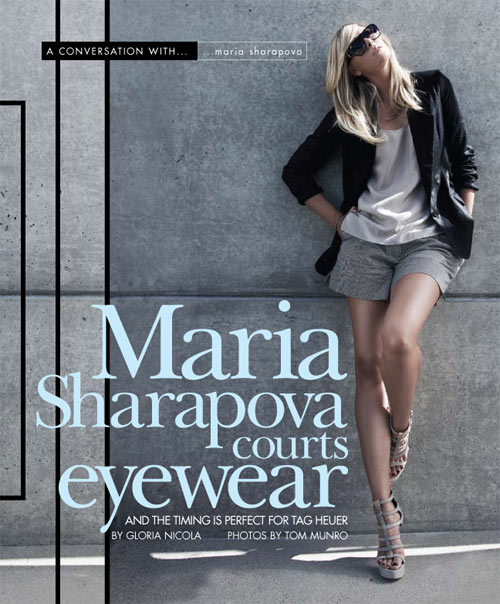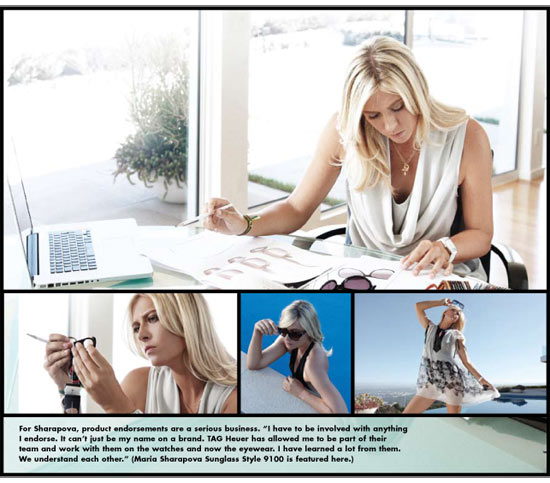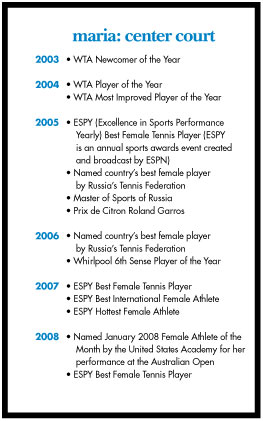
By the age of four Maria Sharapova knew she wanted to play tennis. “I watched my dad play with friends and I would pick up his racket and hit the ball around, not knowing what I was doing.” But not for long. The Russian-born tennis player soon received her own racket and began practicing regularly with her father in a local park.
When she was six, she attended a tennis clinic in Moscow, where it was recommended she receive professional training at the Nick Bollettieri Tennis Academy in Florida. In 1994, when she was seven, she and her father moved to Florida (visa restrictions prevented her mother from joining them for two years). In the very next year, she was signed by IMG, a diversified sports, entertainment and media company.
After rising through the junior and professional ranks, Sharapova won the first of three Grand Slam titles at Wimbledon in 2004 at the age of 17, the third youngest player ever to win Wimbledon. In the two years that followed, she won the 2006 U.S. Open, as well as, eight titles on the Women’s Tennis Association (WTA) Tour. She also had two stints as the World No. 1. However, in 2007 and again in 2008 (the year she won the Australian Open), shoulder injuries forced her to withdraw from the sport. She returned in May 2009 and, as of October 2009, ranked World No. 14.
Sharapova’s public profile is diverse, extends well beyond tennis. She’s been featured in a number of modeling assignments, including the 2006 Sports Illustrated swimsuit issue. Since February 2007, she has been a United Nations Development Project Goodwill ambassador, focusing specifically on efforts in Chernobyl to recover from the 1986 nuclear disaster. She has appeared on such programs as NBC’s “TODAYshow” and “The Tonight Show,” “Entertainment Tonight,” “Live with Regis and Kelly” and “Access Hollywood.” People magazine named her one of the 50 most beautiful celebrities in the world and Forbes magazine, one of the world’s richest female athletes.
“One of the greatest things about being an athlete and making money is realizing you can help the world. I especially love working with children,” the tennis professional says. “And I like the fact at my age, 22, I’ve been to all the continents and have experienced so many different cultures.”

Sharapova also has had numerous sponsorships, including Nike, Sony Ericsson, Canon, Gatorade and Tropicana and has her own line of handbags and shoes with Cole Haan, introduced in 2009, and a fragrance line with Parlux. For the past five years, she has worked with TAG Heuer, as a spokesperson for the company’s watches and more recently for a new collection of TAG Heuer sunglasses created specifically for women and available from the Weston, Fla.-based Premiere Vision.
For Sharapova, product endorsements are a serious business. “I have to be involved with anything I endorse. It can’t just be my name on a brand,” she emphasizes. “TAG Heuer has allowed me to be part of their team and work with them on the watches and now the eyewear. As a 22-year-old, I feel I have learned a lot from them. We understand each other.”
When TAG Heuer decided to introduce a women’s collection of sunglasses, Sharapova was a natural choice because of her relationship with TAG Heuer watches. “After the TAG Heuer eyewear line launched in 2002, it quickly established itself as a style leader in the male market for its innovative, ultra-light design and high-tech performance,” a spokesperson for TAG Heuer says. “We knew repeating this success with women was going to be a challenge so we turned to a tried and true source of style advice who once again rose to the challenge. When it comes to fashion, Maria Sharapova doesn’t need a coach. Her approach to eyewear design reflects the boldness and brashness of her youth and can be summed up in two words: style first.”
Whether they be handbags or sunglasses, accessories are very important to Sharapova. “I need them to complement my hectic lifestyle and go easily from casual to luxurious—from a plane to a press conference. I like feminine and elegant, but that doesn’t mean I won’t wear a leather jacket. I want product that represents all aspects of my lifestyle and I expect it to be just fashionable enough and have enough beauty to suit whatever I wear without being too over the top,” she notes. “I also expect quality and a lot of attention to detail and most important, I want comfort.” Her colors of choice are neutrals such as beige, black and burgundy. “I like layering textures, but I don’t like crazy colors or bright prints,” she notes.
 Sharapova finds working with sunwear especially interesting. “Eyewear is very different from other accessories because it has to be able to accommodate so many facial shapes.” When describing sunglass styles she has gravitated toward in the past, she says, “they have been all over the map, but I don’t like anything too big.”
Sharapova finds working with sunwear especially interesting. “Eyewear is very different from other accessories because it has to be able to accommodate so many facial shapes.” When describing sunglass styles she has gravitated toward in the past, she says, “they have been all over the map, but I don’t like anything too big.”
The new Maria Sharapova collection by TAG Heuer includes two styles: the iconic aviator and a gracefully oversized round, offered in colors which suit her tastes—black with gray or gradient lenses, ivory with blue lenses, tortoise with brown lenses and dark plum with pink lenses.
Although her public profile extends well beyond tennis, Sharapova is still a fierce competitor at heart. “I love going one on one,” she notes. “I know it’s ess-ential to practice, but I would rather be out there on the court competing.”
When not competing or traveling, the tennis star enjoys doing simple things, going to the market to shop for food near her home in Manhattan Beach, Calif., cooking and reading Sherlock Holmes. “A change of pace, occasionally, is good,” she says.
Sharapova’s advice to someone starting out in sports: “Whatever sport you are doing, love what you are doing. And give it your best so you won’t regret what you have done.” And she expects the same from herself. “At the end of my career, I want people to see that I loved what I did,” she explains. “I continue to hold myself to a higher standard than anyone expects of me. I made my own dream a reality. Sure, it’s hard work, full of challenging experiences. I left my mom and my country at seven. But as my mom said to me, ‘life is like the lines on a zebra. You will go through dark patches, but there are also the light, good patches to look forward to because life is a cycle—a mix of heavy and light.’ And the reward is holding up a trophy. That’s a darn good feeling,” Sharapova emphasizes.
Her future goals including more trophy lifting: “Get back to No. 1. And get some more grand slams in.”











